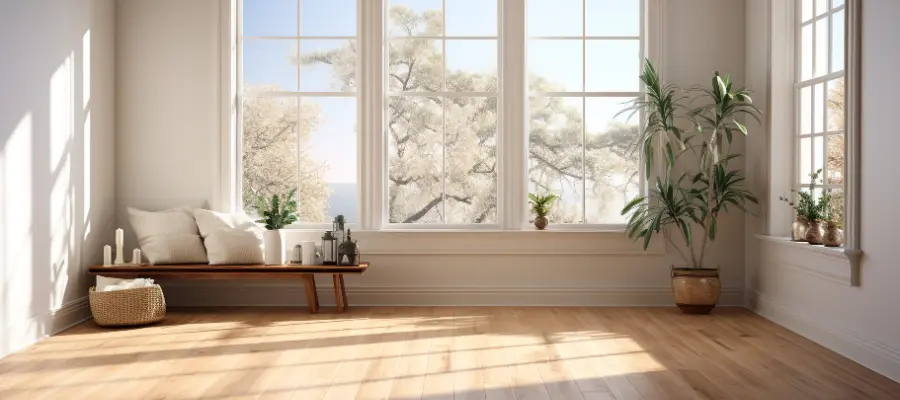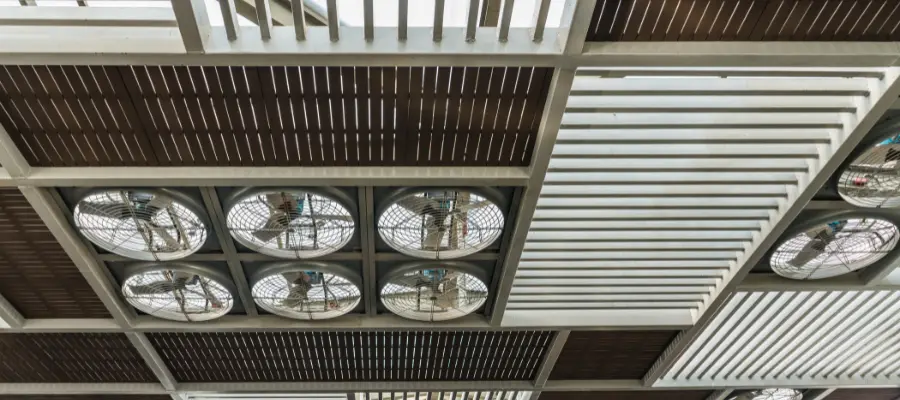People require fresh air to live comfortably and achieve optimal health. In urban areas, a lack of land gives rise to the construction of stacked building blocks. Since the stacked buildings are built nearby, proper ventilation will be difficult to achieve.
In today’s blog of Brick & Bolt, you will understand air ventilation for homes, their benefits, different air ventilation methods, ventilation in different home areas, and sustainable and eco-friendly ventilation solutions.
Understanding Air Ventilation for Home
Ventilation is the process of bringing fresh outdoor air into a home or building and circulating it around the space to enhance air quality. Natural methods, mechanical methods, or a combination of both can accomplish this. Air ventilation is a crucial way of eliminating air impurities from buildings and is necessary for both high indoor air quality (IAQ) and thermal comfort.
Benefits of Proper Air Ventilation for Homes
Without a proper ventilation system in place, you have no control over the airflow in a building. The following are the main advantages of air ventilation systems for homes:
Air Ventilation Avoids Condensation
An air ventilation system for homes avoids condensation and offers structural benefits.
In the winter, the considerable temperature differential between indoors and outdoors allows heated interior air to retain more moisture. When the indoor temperatures drop, the air will no longer be able to carry all of the moisture. Thus, it results in condensation on cold surfaces such as windows and walls. Continuous condensation can result in moist areas, peeling wallpaper, and the growth of black mould, all of which pose health threats. A condensation control device requires appropriate air ventilation to increase air circulation, reduce moisture levels, and maintain a fresh, healthy environment free of condensation.
Air Ventilation Offers a Healthier Environment
A good air ventilation system for home will help you avoid skin allergies, asthma attacks, eczema, watery eyes, itching, sneezing, and a runny nose, directly or indirectly. You can also improve indoor air quality by having air-purifying plants in your home.
Control of Indoor Air Quality
Volatile organic compounds (VOC) can develop from cooking or using chemicals, causing breathing issues. With air ventilation, you can take steps to improve your indoor air quality.
Carbon dioxide, a common indoor air pollutant, can also build up in a house, significantly lowering indoor air quality. However, with a well-maintained and controlled ventilation system, you may successfully reduce CO2 accumulation. Monitoring CO2 levels might also be a good predictor of other potential air quality issues. Taking control of your home’s ventilation not only improves indoor air quality but also lowers the danger of respiratory viruses.
Removes Bad Odour
Poor ventilation can also cause foul odours in buildings. Because of the absence of ventilation, foul odours will be generated in the enclosed location. Air ventilation will eliminate this scenario.
Methods to Improve Air Ventilation for Homes

There are numerous ways to improve the air ventilation of your home or desired building. The following are the key methods to consider:
Natural Ventilation in Buildings
For centuries, natural ventilation has been the most commonly used method for the ventilation process in homes. It involves sufficient use of natural things like different types of windows, doors, and roof turrets across the different parts of the walls without using fans or other mechanical means. For both balconies and outdoor living areas, you can strategically design the required window types in a windward direction. Pressure-driven and stack ventilation are two other methods for providing natural ventilation.
Mechanical Ventilation in Buildings
Opening up the windows to let fresh air in isn’t always possible, particularly when it’s cold or hot and humid outdoors. In those cases, you should consider mechanical home ventilation or heat recovery ventilation. Heat recovery ventilation uses the air in and/or out of a building with the help of electricity or other sources of power. The building may require filtering or cleaning the outside air, depending on their source. The principle of supply and extraction states that one set of ducts and inlet grilles brings outside air into a space, while another set of ducts extracts the stale air and exhausts it outside. Incoming air can be found in diffusers on the ceiling, wall, or floor. Mechanical ventilation can fulfill house requirements like controlled, personalized, and local exhaust ventilation.
Smart Ventilation System
Smart ventilation is all about the integration of systems, which means that ventilation systems are automatically adjusted on a regular basis to meet the desired interior air quality. The smart ventilation system focuses on delivering ventilation while lowering energy usage, utility bills, and other costs. A smart ventilation system regulates the ventilation rate based on the building’s location, occupancy level, air quality conditions, and electrical grid requirements, among other factors. Sensors in the smart ventilation system send out alerts when the system needs to be maintained.
Smart ventilation systems are very responsive and can instantly alter the ventilation in the building. It can provide warnings based on the indoor-outdoor temperature and air quality index.
Mixed-Mode Ventilation System
The mixed-mode (hybrid) ventilation system combines different types of ventilation services, such as natural ventilation and mechanical systems, and includes all the best features.
The hybrid system is an economical ventilation system that enhances indoor air quality. It maintains the indoor climate, provides thermal comfort for occupants, and reduces carbon dioxide levels. These hybrid systems are commonly utilised in offices since they help increase employee productivity by providing a comfortable environment.
Air Ventilation in Different Home Areas

Kitchen Air Ventilation
The kitchen requires proper air ventilation to remove pollutants. You can place kitchen chimneys and exhaust fans to direct cooking odours and smoke outside. You can read more about Tips for Designing a Functional Kitchen for better design ideas.
Bathrooms Air Ventilation
Proper ventilation in bathrooms is very important to maintain good air quality by removing moisture and odours. Otherwise, it can have adverse effects on health.
Make sure to install extractor fans in toilets and bathrooms.
Basements and Attics Air Ventilation
Consider adding exhaust fans if you reside in basements and attics with inadequate ventilation owing to poor airflow.
Sustainable and Eco-friendly Ventilation Solutions
- You can use green building practices to provide sustainable and eco-friendly ventilation.
- You can include ventilation as per sustainable design principles to ensure natural ventilation and reduce reliance on mechanical systems.
- You can also use natural elements or sustainable building materials, such as bamboo, green roofs, and living walls, to improve natural air filtration and indoor air quality.
Conclusion
A proper air ventilation system for home is critical for maintaining a healthy and comfortable living environment, particularly in urban locations with limited space. Smart ventilation systems will be better suited for energy-efficient ventilation systems in urban locations. By implementing sustainable and eco-friendly home design strategies , homes can improve air quality and minimise their reliance on mechanical systems. Irrespective of natural techniques or complex technical solutions, prioritising air ventilation is critical for producing a healthy, efficient, and comfortable living environment.

